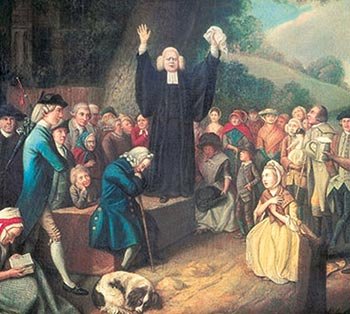First Great Awakening 1727

The Moravian Community at Herrnhut
Commonly called “The Great Awakening” this was certainly not the greatest revival in numerical growth or geographical scope. Nevertheless, it well deserves the title because it was the first discernible occasion that God’s Spirit was outpoured simultaneously across different nations.
Moravian beginnings
Historically, the beginning of this awakening can be traced to the Moravian community called “Herrnhut” (the Lord’s watch), where a visitation from God was experienced after a period of prayer, repentance and reconciliation in 1727. Nikolas Count Ludwig Von Zinzendorf, a German, was the leader of the movement that began a 24 hour-a-day prayer meeting, which lasted the next 100 years. In the next 65 years that small community sent out 300 radical missionaries. Their revived German Pietism was destined to influence two other harvest fields, which were on God’s agenda for that time – England and America.
Spreads to England and America
Griffith Jones, a young Anglican clergyman, often called the ‘morning star of the revival,’ was making a mark in Britain through his revival preaching for at least 10 years before Theodore Frelinghuysen, a Dutch reformed Pietist, began to see remarkable conversions in America. He preached in 1727 with revival signs following his ministry in New Jersey.
The revival spread to the Scottish-Irish Presbyterians under the ministry of Gilbert Tennant, whose father, William, founded the famous “Log College”, which later became the Princeton University. Revival then spread to the Baptists of Pennsylvania and Virginia before the extraordinary awakening that occurred on Northampton, Massachusetts, under the ministry of Jonathan Edwards in 1734.
Edward’s personal experience of revivals and his sharp mind enabled him to produce a number of revival theologies and pastoral observations, which have yet to be surpassed in their wisdom and insight. Thereafter, the revival spread to England and was further advanced in America by a visit of George Whitefield in 1739.
The effects of the revival were phenomenal. Statistics are hard to find, but we know that 150 new Congregational churches began in a 20-year period and 30,000 were added to the church between 1740 and 1742, probably doubling its size. Moral results were equably noticeable. Nine university colleges were established in the colonies.
The wild frontier society was thoroughly Christianised. Early missionary desire began to emerge, most notably in the ministry of David Brainerd among the Indians. His journals are essential reading for all those seeking revival.
Britain’s major fire carriers

George Whitefield Preaching
Back in Britain a massive movement of revival had began and was bound up with the ministries of two young men, George Whitefield and John Wesley. Both had been members of the Holy Club in Oxford while they were students. Wesley went off, still unconverted, to America to preach to the Indians in 1736, returning in 1738.
The only benefit of this venture was his contact with the Moravians, who he could not understand, but for whom he had a great respect. On Wesley’s return, Whitefield had been converted and was already preaching with great effect.
For 34 years he exercised a most amazing preaching ministry, with revival signs often following him. His eloquence was commanding and convincing, full of vivid pictures and graphic expressions. “His hearers were taken by surprise and carried by storm” (J C Ryle).
The height of Whitefield’s ministry was at the famed Cambuslang Awakening in 1742, when 20,000 and 30,000 people gathered to hear him preach, followed by mass weeping and repentance for 1½ hours.
During Whitefield’s ministry he preached in almost every town of England, Scotland and Wales, crossing the Atlantic seven times; winning countless souls in Boston, New York and Philadelphia. He publicly preached an estimated 18,000 power-packed messages, although none of his 75 recorded sermons do justice to his style and delivery.

Artist’s impression of Wesley preaching
Whitefield’s friend, John Wesley, must go down in history as the architect of the 18th century evangelical revival. Converted in 1738, at the well-known Aldersgate Street prayer meeting, he proceeded to preach whenever the opportunity afforded itself, usually in church. Then, in 1739, at Whitefield’s request, he preached in the open air at Bristol and followed Whitefield in his preaching places.
There began those unusual manifestations, which periodically attended his and Whitefield’s ministry; falling, crying out, fainting, shrieking, convulsions etc.
Wesley wisely began small societies designed for mutual encouragement and support. These became forerunners of the class-meetings and then of the Methodist Church. They were surely used to conserve the fruits of his revivalistic work. Wesley was an itinerant preacher for 65 years. He travelled an estimated 250,000 miles on horseback to preach 40,000 sermons! He wrote 233 books, including his voluminous journals and a complete commentary on the whole bible.
He left behind him 750 preachers in England, 350 in America; 76, 968 Methodists in England and 57,621 in America. With Charles, his brother, he penned 9,000 hymns. Wesley’s influence has far outrun his long life. His practices and theology has affected Holiness, Revivalist, Pentecostal and Charismatic groups right down to the present day.
The First Great Awakening: Conclusions
Clearly, then this Awakening was truly ‘Great’ and had notable affect on the majority of countries where Evangelical Christians could be found. It affected the existing church, saw thousands converted and impacted social conditions. Historians usually refer to 1766, the year of the American Revolution, as the year by which the revival had spent itself and had began to decline.
For further research:
The First Great Awakening A comprehensive overview.
On this site:
Introduction
The Great Awakening – Moravians
The Great Awakening – George Whitefield
The Great Awakening – Jonathan Edwards



